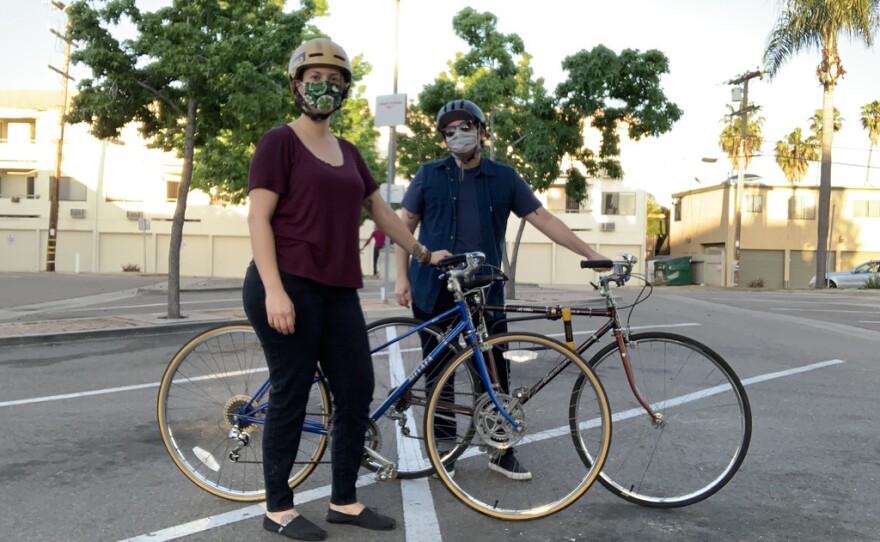The coronavirus pandemic and California's stay-at-home order have led to record low traffic volumes on streets and highways — but in some areas, the opposite is true for sidewalks.
Many San Diegans are seeking respite from their quarantine by taking walks, jogging or riding bikes. Pedestrians, however, often have to enter the street to avoid coming into close contact with others.
Safe streets advocates want the city to adapt some of its roadways to this new reality to prevent both collisions and the spread of COVID-19.
Last week, representatives from 12 different advocacy groups co-signed a letter to Mayor Kevin Faulconer asking him to make changes to local streets during the pandemic. Among other things, they are calling for pedestrian signals at intersections to be made automatic, so people don't have to risk spreading germs by touching crosswalk buttons.
Also, on some streets with higher pedestrian volumes — specifically Mission Boulevard, Sixth Avenue and University Avenue — the advocates want the city to cut vehicle lanes or parking so pedestrians and cyclists have more room for social distancing.
City officials are working on a plan in response to the letter, but no announcements have been made.
RELATED: North Park’s 30th Street To Get Protected Bike Lanes
North Park resident Ann King-Concialdi said she and her wife are taking longer, more leisurely bike rides than normal, and that having fewer cars on the streets has made their trips much more peaceful.
"You can go at a slower pace, sometimes we'll kind of zig-zag through the side streets now instead of taking just one straight route," she said. "Now we just get to kind of enjoy the roads."
Adam Dingley, who regularly bikes to work from his home in La Mesa to his job in Spring Valley, said he feels much safer on the roads with fewer cars and more cyclists around.
"Without people out on the roads riding bikes, cars aren't used to looking for them," Dingley said. "So the more they're out there, the safer it is for everybody."
Bike shops are seeing more business, too. Dan Zapkowski, owner of Pacific Beach Bikes, said he's seeing a flood of new customers — many of them young adults looking for new ways to exercise and parents who want to ride with their kids but don't have bikes of their own.
RELATED: Social Distancing Disrupts Routines For Neighborhood Planning Groups
"We have an online store, so we've been selling a ton of bikes online," he said. "We're also seeing a huge uptick in (refurbishing) old bikes that have been sitting around for 5, 10 years."
Andy Hanshaw, executive director of the San Diego County Bicycle Coalition and one of the co-signers of the letter to Faulconer, said San Diego has some catching up to do with adapting its streets to the coronavirus era.
"We started to see several cities across the country implement slow street initiatives or networks almost instantly or very swiftly to alleviate the similar problem that we were having here," he said, referring to crowding on sidewalks.
Earlier this month Oakland Mayor Libby Schaaf announced the city would limit car travel on 74 miles of streets to local traffic only. Officials in San Francisco announced a similar initiative on Tuesday, along with plans to expand the city's "Slow Streets" network each week. And last week the La Mesa City Council voted to make busy pedestrian crossings touchless and automatic.
RELATED: Coronavirus Prompts MTS To Put 2020 Tax Measure On Hold
Hanshaw said the pandemic is providing an opportunity to help more people experience the benefits of safer streets — particularly families with young children being able to spend time together outdoors in a safe environment.
"Our hope is that once we get through this that we just don't go back to the same old same old," he said. "It's created a sort of vision of what's possible.
Zapkowski, the bike shop owner, said he also hopes people stick with their bikes after the need for strict social distancing is over and some of San Diego's most popular routes, such as the boardwalk or the Mission Bay bike path, reopen.
"I hope that people will get to enjoy the same things I get to do when I get to ride my bike on the boardwalk," he said. "Go grab a sunset and I guarantee you're gonna come home with a smile on your face."







